Worm-eating Warbler Bird
- December 15, 2023
- 0 comment
Worm-eating Warbler(Helmitheros vermivorum), The genus name, Helmitheros, comes from the Greek words for “helminthos” (worm) and “therizo” (to hunt), referring to the bird’s diet of insects. The species name, vermivorum, is also Latin for “worm-eating.”
Physical Appearance
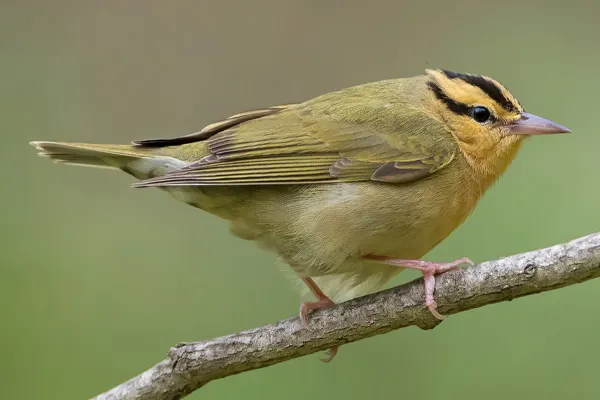
Worm-eating Warbler
- Lifespan: 4-6 years
- Habitat: Deciduous forests and rich vegetation like laurel, rhododendron, holly, or dogwood.
- Diet: Insects, Spiders, Caterpillars, Beetles, Flies, and Ants
- Size: 4.7-5.1 inches
- Weight: 0.44 ounces
- Wingspan: 7.9-9.1 inches
- Conservation Status: Least Concern
- Population Trend: Population Increasing)
The Worm-eating Warbler is a small songbird that breeds in the eastern United States and migrates to Central America and the Caribbean for the winter. It is a member of the family Parulidae, which includes all of the New World wood-warblers.
Species Type
The Worm-eating Warbler (Helmitheros vermivorum) is a small songbird species belonging to the family Parulidae, commonly known as wood-warblers. These birds are named after their diet, which consists primarily of insects and invertebrates like caterpillars, beetles, and spiders.
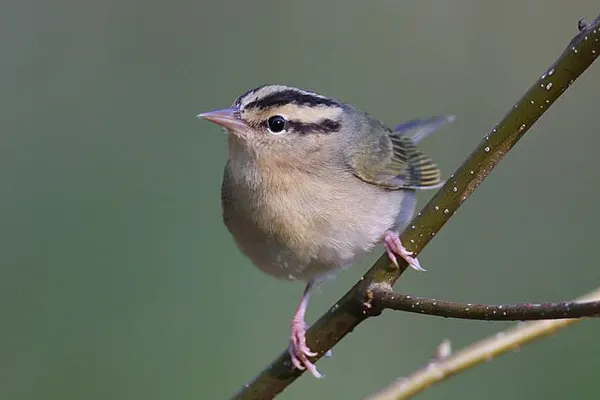
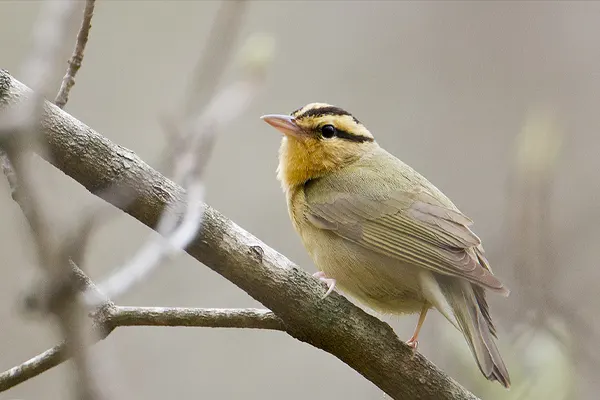
- Kingdom: Animalia
- Phylum: Chordata
- Class: Aves
- Order: Passeriformes
- Family: Parulidae
- Genus: Helmitheros
- Species: H. vermivorum
- Binomial Name: Helmitheros vermivorum
- Common Names: Worm-eating Warbler, Worm-eating Wood-warbler
Feather Coloration
The Worm-eating Warbler’s plumage is a fascinating example of how colors and patterns can be used for both camouflage and identification. The olive-brown upperparts and buff underparts help the bird blend into its forest environment, while the black stripes and eye markings add unique features for recognition by other birds.
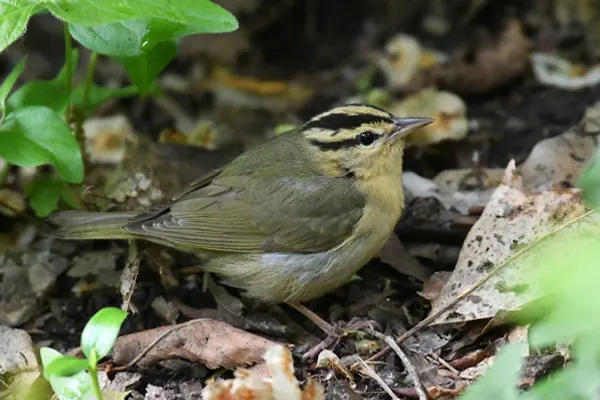
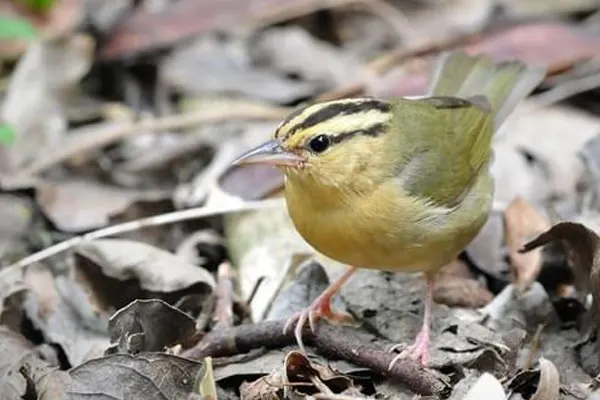
- The intensity of the olive-brown and buff shades can vary slightly between individual birds.
- The feathers are not static and can be fluffed or flattened, slightly altering the overall appearance.
- The coloration can be affected by age, sex, and season.
- Observing the feather coloration is a valuable tool for birdwatchers to identify the Worm-eating Warbler in the field.
Flight Characteristics
Worm-eating Warbler’s flight characteristics are a testament to its adaptability and specialization for life in the understory of North American forests. Its agility, maneuverability, and diverse flight patterns allow it to thrive in its complex environment and successfully navigate the challenges of foraging, nesting, and migration.
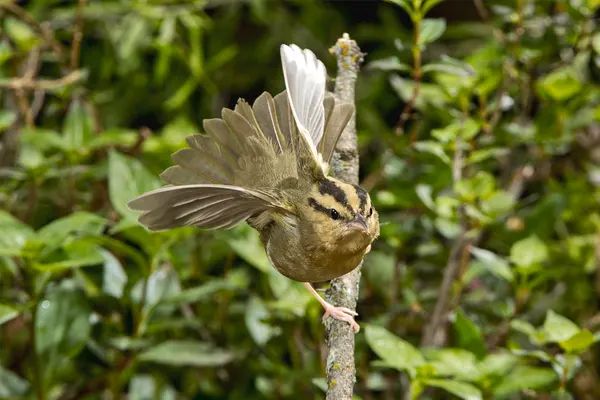
Wing Shape and Size
- The Worm-eating Warbler possesses relatively short, rounded wings, well-suited for maneuvering through dense undergrowth and tight spaces within the forest canopy.
- The wings are also fairly broad, providing good lift for short bursts of powerful flight and hovering.
Flight Patterns
- Low and Agile: The Worm-eating Warbler typically flies low to the ground, often dipping and flitting between branches and foliage. This agility helps it navigate the complex forest structure and pursue insects hiding within the undergrowth.
- Short Bursts and Hovers: The bird utilizes short bursts of rapid wingbeats interspersed with brief periods of hovering. This allows it to meticulously search for prey among leaves and debris on the forest floor.
- Direct and Purposeful: While capable of bursts of speed, the Worm-eating Warbler’s flight is generally direct and purposeful, focusing on foraging and territorial defense rather than long-distance travel.
- Song Flight: During courtship displays, males engage in a unique flight behavior. They ascend into the air while singing a fast-paced, musical song, which helps attract females and establish territorial boundaries.
Migration Patterns
The Worm-eating Warbler (Helmitheros vermivorum) is a small, migratory songbird that breeds in eastern North America and winters in Central America and the Caribbean. By understanding the migration patterns of the Worm-eating Warbler, we can better protect these fascinating birds and ensure their survival for generations to come.
Migration
- During their long-distance migrations, Worm-eating Warblers engage in sustained, high-altitude flight. They utilize thermals to conserve energy and cover long distances efficiently.
- While the exact flight patterns and routes are still being studied, they are believed to fly primarily at night, offering protection from predators and weather extremes.
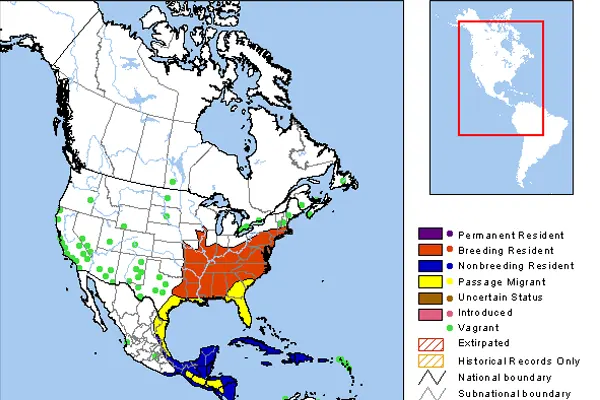

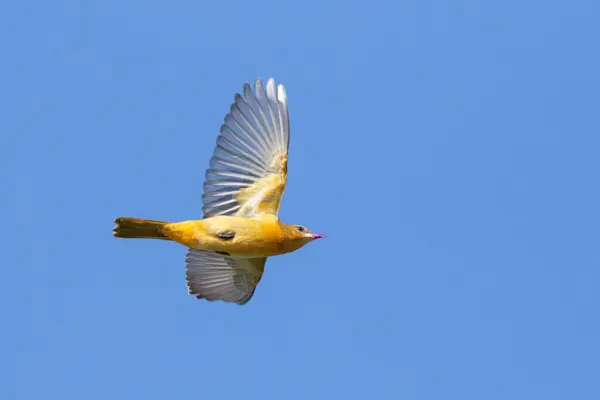
Migration Timing
- Spring migration: Begins in March-April, with northbound birds reaching breeding grounds by May-June.
- Fall migration: Begins in August-September, with southbound birds reaching wintering grounds by October-November.
Migration Routes
- Northbound: Birds fly primarily on a northwesterly course, following the eastern edge of the Mississippi River valley and the Appalachian Mountains.
- Southbound: Birds follow a more complex, looping route, with some individuals crossing the Gulf of Mexico directly and others traveling around the Gulf Coast.
Migration Strategies
- Nocturnal: Worm-eating Warblers migrate primarily at night, likely to avoid predators and conserve energy.
- High Altitude: During migration, they fly at high altitudes (up to 12,000 feet) to take advantage of favorable winds and air currents.
- Stopover Sites: Birds make multiple stopover sites along their migration routes to rest and refuel. These stopover sites are often areas with abundant food and water resources, such as coastal areas, riparian corridors, and agricultural fields.
Habitat & Distribution
The Worm-eating Warbler is a small, migratory songbird that is native to North America. It breeds in eastern deciduous forests and migrates to Central America and the Caribbean for the winter. By understanding the habitat and distribution of the Worm-eating Warbler, we can better protect this fascinating bird and ensure its survival for generations to come.
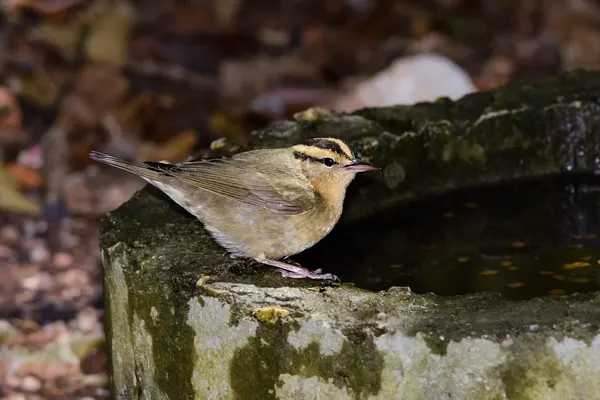
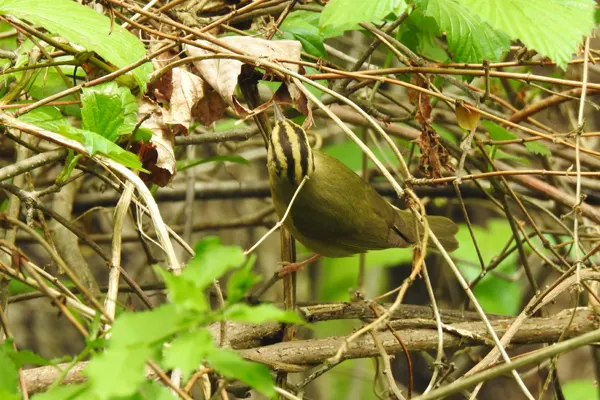
Wintering Habitat
- Type of Forests
- Mangrove forests
- Dry woodlands
- Tropical rainforests
- Coffee plantations
- Mountain forests
- Specific Features
- A dense understory with plenty of insects to eat.
- A warm climate, as the warbler is sensitive to cold weather.
- Protection from predators, such as dense vegetation or thickets.
- Wintering Locations
- Southern Mexico
- Central America
- Caribbean Islands
Distribution
- Breeding Range: The breeding range of the Worm-eating Warbler extends from southern Canada down to the Gulf Coast. The exact boundaries of its breeding range can vary slightly from year to year.
- Wintering Range: The wintering range of the Worm-eating Warbler includes Central America and the Caribbean. The specific locations where individual birds winter can vary depending on factors such as food availability and weather conditions.
Behavioral Traits
The Worm-eating Warbler, a small but captivating songbird, exhibits a diverse range of behavioral traits that help it thrive in the complex environment of the forest understory. By appreciating their intricate behaviors, we gain a deeper understanding of this remarkable species and its crucial role in the forest ecosystem.

Foraging & Feeding
- Ground-foraging specialist: Unlike most warblers, the Worm-eating Warbler primarily forages on the ground, utilizing its long, curved bill to probe into leaf litter and debris in search of insects and spiders.
- Caterpillar connoisseur: True to its name, the warbler’s diet heavily relies on caterpillars, making it an important predator of these often-abundant insects.
- Gleaning and probing: It employs a combination of techniques, gleaning insects from leaves and bark and meticulously probing into crevices and dead leaves for hidden prey.
- Cooperative foraging: Occasionally, pairs of Worm-eating Warblers may be observed foraging together, sharing resources and increasing their efficiency in finding food.
Role in Ecosystem
The Worm-eating Warbler plays a complex and multifaceted role in the forest ecosystem. Its impact extends beyond simple insect control, contributing to nutrient cycling, seed dispersal, and even serving as an indicator of environmental health. By understanding and appreciating its ecological importance, we can better manage and protect the forests it calls home.
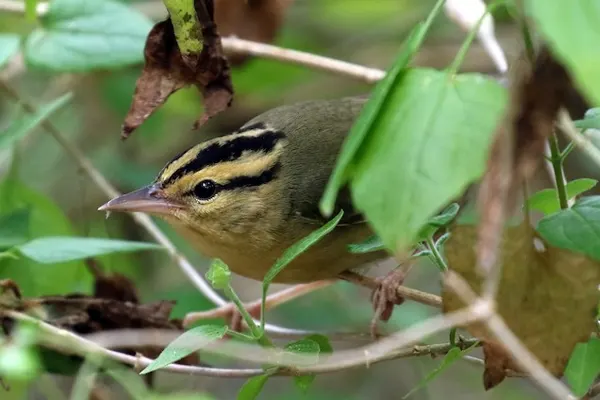
Insect Control
- Primary predator: The Worm-eating Warbler acts as a primary predator of insects, particularly caterpillars. By consuming large quantities of these herbivores, it helps to regulate their populations and prevent them from causing damage to plants and trees.
- Dietary diversity: Its diet also includes a variety of other insects, including beetles, spiders, and flies, further contributing to overall insect population control within the ecosystem.
Forest Health
- Nutrient cycling: By consuming insects and spiders that feed on plant leaves and other organic matter, the Worm-eating Warbler participates in the essential process of nutrient cycling. This ensures the efficient breakdown and recycling of nutrients within the ecosystem, promoting healthy plant growth and overall ecosystem productivity.
- Seed dispersal: While less common, the Worm-eating Warbler may occasionally consume fruits and berries. This can contribute to seed dispersal, assisting in the regeneration of plant populations and the maintenance of forest diversity.
Indicator Species
- Sensitivity to habitat changes: The Worm-eating Warbler is considered an indicator species, meaning its presence or absence can provide valuable information about the overall health of the forest ecosystem. Its sensitivity to habitat loss, pollution, and other environmental disturbances makes it a useful tool for monitoring the ecological status of the environment.
- Early warning system: By studying the population trends and behavior of the Worm-eating Warbler, scientists can gain valuable insights into potential threats to the ecosystem and take early action to address them.
Food Source for Other Animals
- Prey for larger predators: While the Worm-eating Warbler itself is a predator, it also serves as prey for various larger animals, including birds of prey, snakes, and small mammals. This integration into the food chain helps maintain the balance of predator-prey relationships within the ecosystem.
Pollination
- Occasional pollen carrier: While not its primary function, the Worm-eating Warbler can occasionally transport pollen between flowers while foraging. This accidental pollination can contribute to plant reproduction and the maintenance of diverse plant communities.
Dietary Habits
The Worm-eating Warbler, despite its name, is not solely reliant on earthworms for its diet. This small songbird exhibits a diverse and adaptable feeding strategy, consuming a variety of invertebrates within the forest understory.
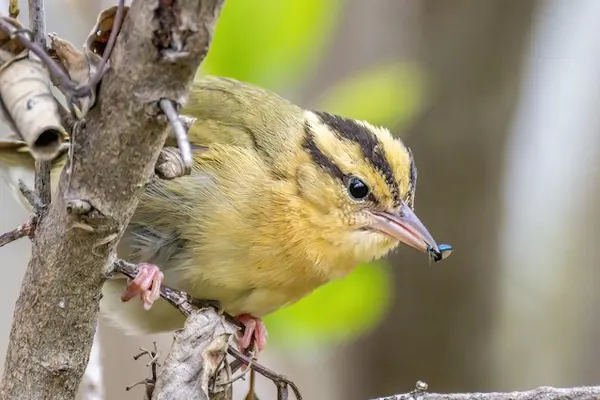

Primary Food Sources
- Insects: The bulk of the Worm-eating Warbler’s diet consists of insects. It primarily targets caterpillars, playing a key role in controlling their populations. Additionally, it consumes a wide variety of other insects including beetles, spiders, flies, ants, bees, walkingsticks, sawfly larvae, and grasshoppers.
- Spiders: While not the primary focus, spiders also contribute significantly to the Worm-eating Warbler’s diet, providing essential protein and nutrients.
Secondary Food Sources
- Fruit: Occasionally, the Worm-eating Warbler may supplement its diet with fruit, especially during the summer and fall months. Berries and small, fleshy fruits can offer additional vitamins and sugars during periods of lower insect availability.
- Seeds: While not a regular dietary component, seeds may be consumed occasionally, particularly during times of food scarcity.
Dietary Adaptations
- Long, curved beak: Its specialized beak is perfectly suited for probing into crevices and extracting insects from hidden locations.
- Sharp claws: Strong claws provide grip and stability while foraging on the ground and maneuvering through dense vegetation.
- Keen eyesight: Excellent vision allows the Worm-eating Warbler to locate insects camouflaged within the forest floor.
Interesting Facts
The Worm-eating Warbler, despite its name, is a captivating bird with a unique set of adaptations and behaviors that allow it to thrive in the forest understory.
- Unusual Ground Nesting: Unlike most warblers that build their nests in trees, the Worm-eating Warbler constructs its cup-shaped nest on the ground, often hidden in dense vegetation. This makes the nest vulnerable to predation, but it also offers some protection from the elements.
- Caterpillar Connoisseur: While not solely reliant on earthworms, the Worm-eating Warbler does live up to its name by primarily feeding on caterpillars. It uses its long, curved beak to probe into the leaf litter and debris on the forest floor, searching for its prey. This foraging technique is unique among warblers and helps the Worm-eating Warbler access a food source that is unavailable to other birds.
- Vocal Virtuoso: The Worm-eating Warbler has a loud, clear song that can be heard throughout its breeding range. The song is a rapid series of trills and chips, and it is often described as being similar to the sound of a sewing machine. The male sings to attract mates and defend his territory.
- Unexpected Long-Distance Traveler: The Worm-eating Warbler migrates long distances between its breeding grounds in the eastern United States and its wintering grounds in Central America and the Caribbean. This migration can be dangerous, and many birds do not survive the journey.
- Uncommon Coloration: The Worm-eating Warbler has a unique coloration that helps it to blend in with its forest habitat. The bird is olive-brown above and buff-colored below, with black stripes on its head. This coloration makes it difficult for predators to spot the bird when it is foraging on the forest floor.
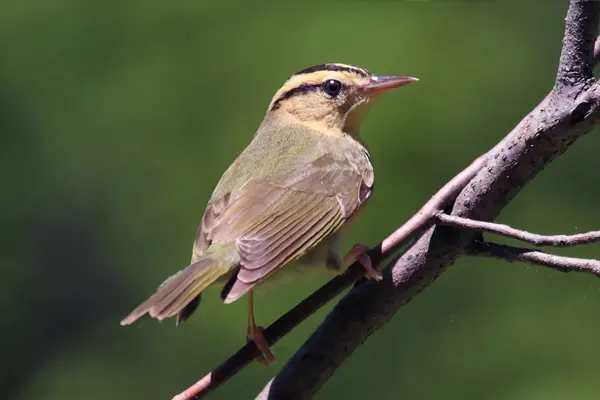
- Resilient Population: Despite facing threats such as habitat loss and fragmentation, the Worm-eating Warbler is a relatively common bird. In fact, its population has been increasing in recent years. This is due to a number of factors, including the conservation of forests and the creation of new habitat.
- Important Insectivore: The Worm-eating Warbler plays an important role in the ecosystem by controlling insect populations. By eating caterpillars and other insects, the Worm-eating Warbler helps to keep these populations in check. This helps to protect plants from being eaten by insects, and it also helps to ensure that there is enough food available for other birds.
- Cultural Significance: The Worm-eating Warbler is a popular bird among birdwatchers and nature enthusiasts. Its unique appearance, behavior, and song make it a fascinating subject for observation. The Worm-eating Warbler is also a symbol of the importance of protecting forests and other natural habitats.
- Exceptional Nest Camouflage: The female Worm-eating Warbler meticulously camouflages her nest with leaves, twigs, and other natural materials. This helps to keep the nest hidden from predators and ensures the survival of her chicks.
- Cooperative Foraging: While primarily solitary birds, pairs of Worm-eating Warblers may occasionally be observed foraging together. This cooperative behavior allows them to cover more ground and find food more efficiently.
- Remarkable Adaptability: The Worm-eating Warbler demonstrates remarkable adaptability in its habitat usage and diet. It can thrive in a variety of forest types and readily adjusts its foraging strategy based on the availability of food sources.
- Indicator Species: Due to its sensitivity to habitat changes, the Worm-eating Warbler is considered an indicator species. Studying its population trends and behavior can provide valuable insights into the overall health of the forest ecosystem.
Nesting Habits
The Worm-eating Warbler, despite its seemingly simple name, exhibits remarkable complexity and dedication when it comes to building its nest and raising its young.
Nest Location
- Ground-loving: Unlike most warblers that build their nests in trees, the Worm-eating Warbler prefers to nest on the ground, often at the base of a shrub, small tree, or amongst dense vegetation.
- Secluded and hidden: The female meticulously chooses a location that offers good camouflage and protection from predators. She may choose a site near a fallen log, under a thick canopy of leaves, or within a tangle of branches.
- Sloped preference: Nesting on slopes is a common characteristic, potentially offering additional drainage and protection from flooding.
Nest Construction
- Cup-shaped design: The Worm-eating Warbler builds a delicate cup-shaped nest using a variety of materials. These include dry leaves, twigs, grasses, bark strips, and even spiderwebs.
- Soft lining: The inner cup is lined with softer materials such as feathers, hair, and plant fibers, creating a comfortable and warm environment for the developing chicks.
- Camouflaged exterior: The female carefully incorporates the surrounding leaves and debris into the nest structure, creating an effective camouflage that blends seamlessly into the forest floor.
Egg-laying and Incubation
- Clutch size: The female typically lays 4-5 eggs, which are small and white with brown speckles.
- Dedicated incubation: The female solely incubates the eggs for 12-13 days, sitting tightly on the nest and fiercely defending it from potential threats.
- Male support: While the female incubates, the male actively forages for food and may occasionally bring it to the nest to feed the female.


Nestling care
- Cooperative feeding: Both parents are involved in feeding their young once they hatch. They work tirelessly to bring a constant supply of insects and other invertebrates to the nest, ensuring the chicks’ rapid growth and development.
- Brood parasitism: Although uncommon, the Worm-eating Warbler can be subjected to brood parasitism by the Brown-headed Cowbird. This occurs when the cowbird lays its eggs in the warbler’s nest, leaving the warbler parents to raise the cowbird chick as their own.
- Fledging and independence: After approximately 10-11 days, the young warblers fledge the nest and begin to learn how to forage for themselves. Their parents continue to provide them with some support for a few weeks after fledging, until they are fully independent.
Threats to nesting
- Habitat loss and fragmentation: The destruction and degradation of forests, especially mature forests with dense understory, are significant threats to the Worm-eating Warbler’s nesting success.
- Predation: Nests and chicks are vulnerable to predation by snakes, raccoons, cats, and other animals.
- Climate change: Rising temperatures and changes in precipitation patterns can negatively impact the availability of food and nesting resources, leading to decreased nesting success.
Melodious Song & Vocalizations
The Worm-eating Warbler is a vocal bird, utilizing a diverse range of calls and songs for communication and territorial defense.
Songs
- Primary song: The most prominent vocalization is the male’s rapid trill, often described as resembling the sound of a sewing machine. This song serves to attract mates and establish territories.
- Flight song: During courtship displays, the male sings a musical, varied song while ascending into the air. This specific song further enhances mate attraction and territorial defense.
Calls
- Chip call: A loud, smacking chip is used for various purposes, including alarm calls, contact calls between mates, and aggressive calls during territorial disputes.
- Tseet call: A softer tseet is primarily used for communication between members of a pair during nesting and while foraging together.
- Flight call: During migration, a similar tseet call is utilized by both males and females.
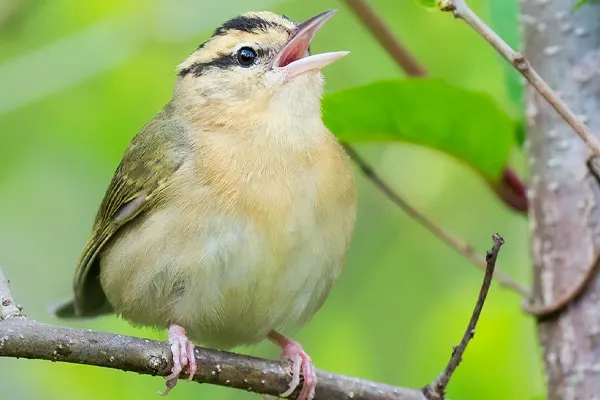
Other Vocalizations
- Chatters and squeaks: These high-pitched sounds are primarily used during aggressive encounters with other birds or potential predators.
- Whispered vocalizations: During the nesting season, parents may use soft, whispered vocalizations to communicate with their young and keep them calm.
Variations in Vocalizations
- Individual differences: Each Worm-eating Warbler can have slight variations in their vocalizations, including the speed and pitch of their songs and calls.
- Geographical variations: Some regional populations may exhibit slight differences in their vocal repertoire, potentially due to local dialects or adaptations.
Functions of Vocalizations
- Communication: Vocalizations play a crucial role in communication between individuals, serving to attract mates, maintain pair bonds, defend territories, raise young, and respond to potential threats.
- Navigation: During migration, calls may be used for navigation and flock cohesion, helping birds stay together and find suitable stopover sites.
- Species recognition: The distinct calls and songs of the Worm-eating Warbler help other birds identify the species and avoid potential interspecies conflicts.
Ecological Significance
The Worm-eating Warbler plays a complex and multifaceted role in the forest ecosystem. Its impact extends beyond simple insect control, contributing to nutrient cycling, seed dispersal, and even serving as an indicator of environmental health. By understanding and appreciating its ecological significance, we can better manage and protect the forests it calls home.
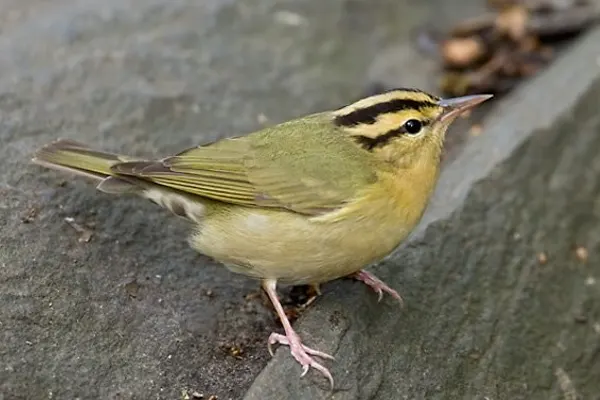
- Primary predator: As a primary predator of insects, particularly caterpillars, the Worm-eating Warbler helps regulate insect populations and prevent them from causing damage to plants and trees. This contributes to maintaining a healthy and balanced ecosystem.
- Efficient decomposers: By consuming insects that feed on plant leaves and other organic matter, the Worm-eating Warbler participates in the essential process of nutrient cycling. This ensures the efficient breakdown and recycling of nutrients within the ecosystem, promoting healthy plant growth and overall ecosystem productivity.
- Environmental barometer: The Worm-eating Warbler is considered an indicator species, meaning its presence or absence can provide valuable information about the overall health of the forest ecosystem. Its sensitivity to habitat loss, pollution, and other environmental disturbances makes it a useful tool for monitoring the ecological status of the environment.
- Prey for larger predators: While the Worm-eating Warbler itself is a predator, it also serves as prey for various larger animals, including birds of prey, snakes, and small mammals. This integration into the food chain helps maintain the balance of predator-prey relationships within the ecosystem.
- Occasional pollen carrier: While not its primary function, the Worm-eating Warbler can occasionally transport pollen between flowers while foraging. This accidental pollination can contribute to plant reproduction and the maintenance of diverse plant communities.
Conservation Status
The Worm-eating Warbler is currently classified as Least Concern by the IUCN Red List of Threatened Species. This means that its population is considered stable and not at immediate risk of extinction.
- Habitat loss and fragmentation: The Worm-eating Warbler relies on mature forests with dense understories for breeding and nesting. Habitat loss due to deforestation, logging, and urban development can significantly impact its population.
- Climate change: Changes in temperature and precipitation patterns can affect the availability of food and nesting sites for the Worm-eating Warbler, potentially leading to population declines.
- Pesticide use: Pesticides can harm insects, which are the primary food source of the Worm-eating Warbler. This can lead to reduced food availability and decreased reproduction.
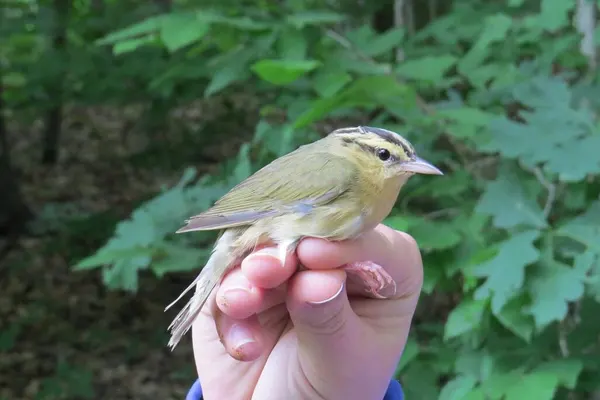
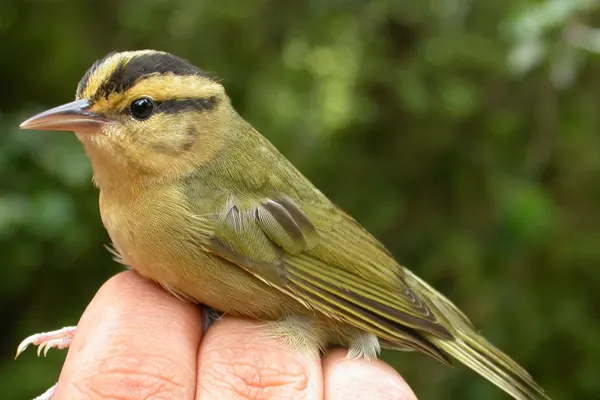
Conservation Efforts:
- Protecting forests: Numerous organizations and government agencies are working to protect and restore forests, providing suitable habitat for the Worm-eating Warbler.
- Habitat management: Managing forests for specific needs of the Worm-eating Warbler, such as maintaining dense understories, can improve its breeding success.
- Public education: Raising awareness about the Worm-eating Warbler and its conservation needs can encourage people to become involved in protecting the species and its habitat.
Research and Ongoing Studies
Continuing to study the Worm-eating Warbler, we can gain valuable insights into its biology, ecology, and conservation needs. This knowledge is crucial for ensuring the survival of this fascinating bird and its critical role in the ecosystem.
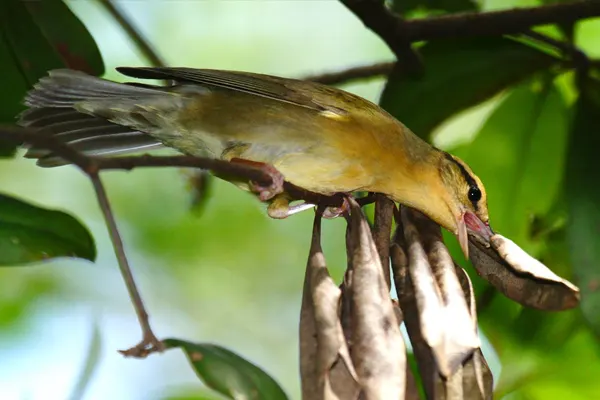
Habitat Use and Selection
- Researchers are studying the specific habitat preferences of the Worm-eating Warbler, including the types of forests they prefer, the characteristics of their breeding and wintering grounds, and the factors influencing their habitat selection.
Migration Patterns and Connectivity
- Scientists are tracking the migration patterns of the Worm-eating Warbler using GPS tags and other technologies. This research helps us understand their migration routes, stopover sites, and the timing of their migrations.
Population Dynamics
- Researchers are monitoring the population trends of the Worm-eating Warbler to assess its overall population health and identify potential threats.
Educational and Ecotourism
The Worm-eating Warbler offers a wealth of educational and ecotourism opportunities for people of all ages. Its unique appearance, fascinating behavior, and vital role in the ecosystem make it an ideal subject for learning and appreciating the wonders of the natural world.
Educational Opportunities
- School Field Trips: Guided tours led by naturalists or educators can provide students with firsthand experience observing Worm-eating Warblers in their natural habitat. These trips can be integrated into various science and environmental studies, enriching the learning experience and fostering a deeper appreciation for birdwatching and conservation.
- Citizen Science Programs: Engaging in citizen science initiatives like eBird allows individuals to contribute valuable data on the distribution and abundance of the Worm-eating Warbler. Participating in projects such as breeding bird surveys or migration monitoring can offer valuable insights into the species’ ecology and contribute to scientific research.
- Lectures and Workshops: Public lectures and workshops conducted by experts can provide in-depth knowledge about the Worm-eating Warbler’s biology, ecology, and conservation challenges. These educational programs help raise awareness about the species and encourage responsible environmental stewardship.
- Educational Resources: Online platforms and educational materials like bird guides, documentaries, and interactive quizzes can be used to learn independently about the Worm-eating Warbler. These resources offer a convenient and accessible way to gain knowledge about this fascinating bird and its role in the environment.
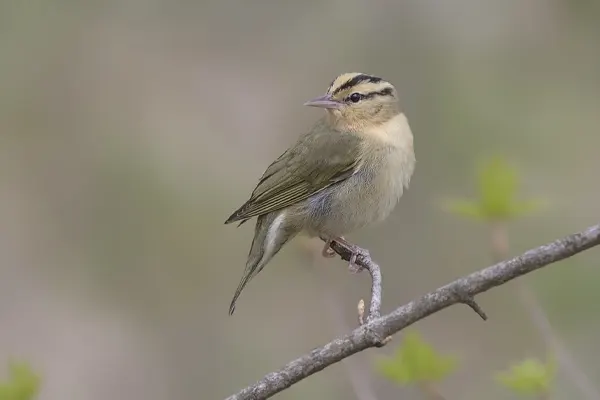
Ecotourism Opportunities
- Birdwatching Tours: Guided birdwatching tours led by experienced guides allow visitors to observe the Worm-eating Warbler and other bird species in their natural habitat. These tours often take place in beautiful natural areas, providing an enriching and immersive experience for nature enthusiasts.
- Nature Photography Workshops: Workshops focusing on bird photography offer participants the opportunity to learn techniques for capturing stunning images of the Worm-eating Warbler and other wildlife. These workshops promote an appreciation for the natural world and encourage responsible photography practices.
- Volunteer Programs: Participating in volunteer programs at wildlife refuges or conservation organizations allows individuals to contribute to the protection of the Worm-eating Warbler and its habitat. Planting native vegetation, restoring degraded areas, and monitoring bird populations are some ways volunteers can actively contribute to conservation efforts.
- Ecolodges and Sustainable Tourism Initiatives: Ecolodges and other sustainable tourism ventures provide visitors with opportunities to experience nature responsibly. These establishments prioritize environmental protection and local community engagement, offering visitors ethical and rewarding experiences while supporting conservation efforts.
Conclusion
The Worm-eating Warbler, with its intricate song and meticulous nesting habits, is a testament to the remarkable diversity and resilience of life in the forest understory. This seemingly unassuming bird plays a vital role in maintaining the delicate balance of the ecosystem, contributing to insect control, nutrient cycling, seed dispersal, and even serving as an indicator of environmental health.
Despite facing challenges like habitat loss and climate change, the Worm-eating Warbler continues to thrive in many areas. Dedicated conservation efforts, ongoing research, and increased public awareness offer hope for the long-term survival of this fascinating species. By understanding and appreciating its role in the environment, we can each play a part in ensuring that the Worm-eating Warbler’s song continues to resonate through the forest for generations to come.




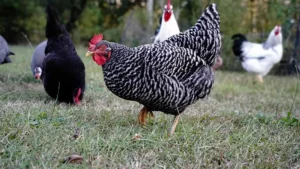
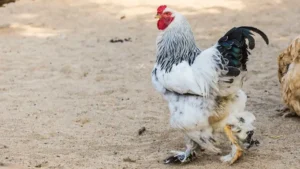
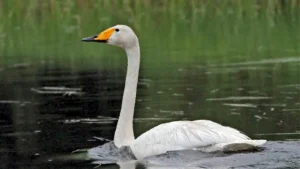

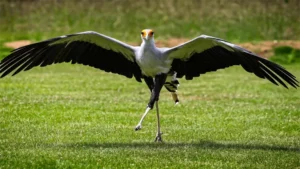

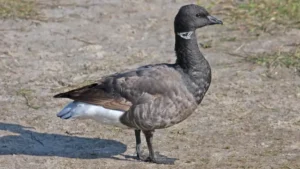

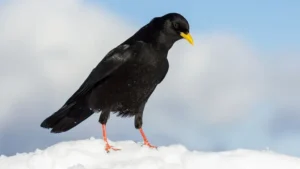
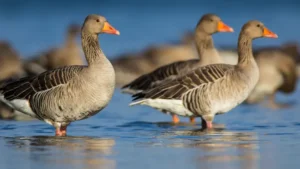
Leave your comment